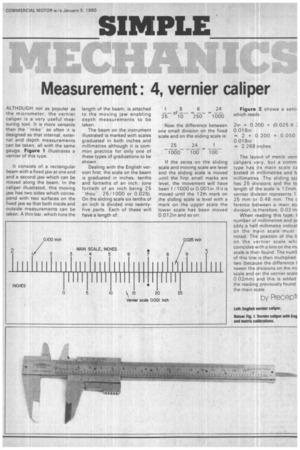Measurement: 4, vernier caliper
Page 43

If you've noticed an error in this article please click here to report it so we can fix it.
ALTHOUGH not as popular as the micrometer, the vernier caliper is a very useful measuring tool. It is more versatile than the -mikeas often it is designed so that internal, external and depth measurements can be taken, all with the same gauge. Figure 1 illustrates a vernier of this type.
It consists of a rectangular beam with a fixed jaw at one end and a second jaw which can be moved along the beam. In the caliper illustrated, this moving jaw has two sides which correspond with two surfaces on the fixed jaw so that both inside and outside measurements can be taken. A thin bar, which runs the length of the beam, is attached to the moving jaw enabling depth measurements to be taken.
The beam on the instrument illustrated is marked with scales graduated in both inches and millimetres although it is common practice for only one of these types of graduations to be shown.
Dealing with the English version first, the scale on the beam is graduated in inches, tenths and fortieths of an inch. (one fortieth of an inch being 25 -thou", 25/1000 or 0.025). On the sliding scale six tenths of an inch is divided into twentyfive parts. Each of these will have a length of:
1 6 6 24
of113— -2 -laTO
Now the difference between one small division on the fixed scale and on the sliding scale is: 25 24 1
—10010— 10-15 100
If the zeros on the sliding scale and moving scale are level and the sliding scale is moved until the first small marks are level, the movement will have been 1/1000 or 0.001 in. If it is moved until the 12th mark on the sliding scale is level with a mark on the upper scale the lower scale has been moved 0.012in and so on. Figure 2 shows a se:nil which reads: 2in + • 0.200 -1(0.025 X 0.018in = 2 + 0.200 40.050 001 81n = 2.268 inches.
The layout of metric vern calipers vary, but a comm type has its main scale ca brated in millimetres and h millimetres. The sliding scz has 25 divisions and the to length Of the scale is 12mm. vernier division represents 1: 25 mm or 0.48 mm. The c ference between a main sc division, is therefore, 0.02 mi
When reading this type, t number of millimetres and pi sibly a half millimetre indicat on the main scale must noted. The position of the Ii on the vernier scale whi coincides with a line on the rniscale is then found. The numb of this line is then multiplied two (because the difference tween the divisions on the r112 scale and on the vernier scale 0.02mm) and this is added the reading previously found the main scale.
by Precept(
















































































